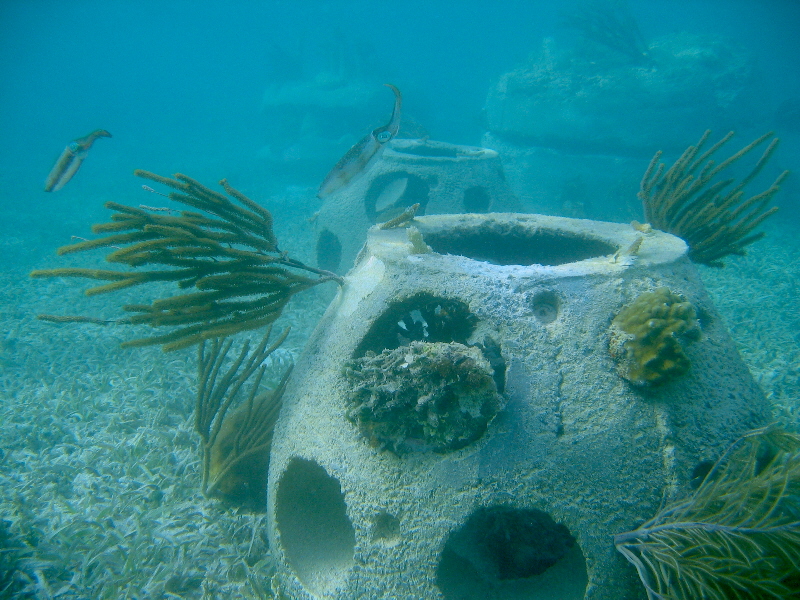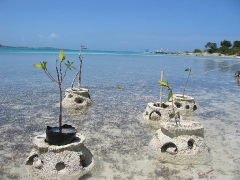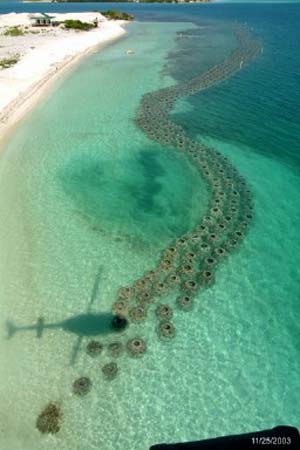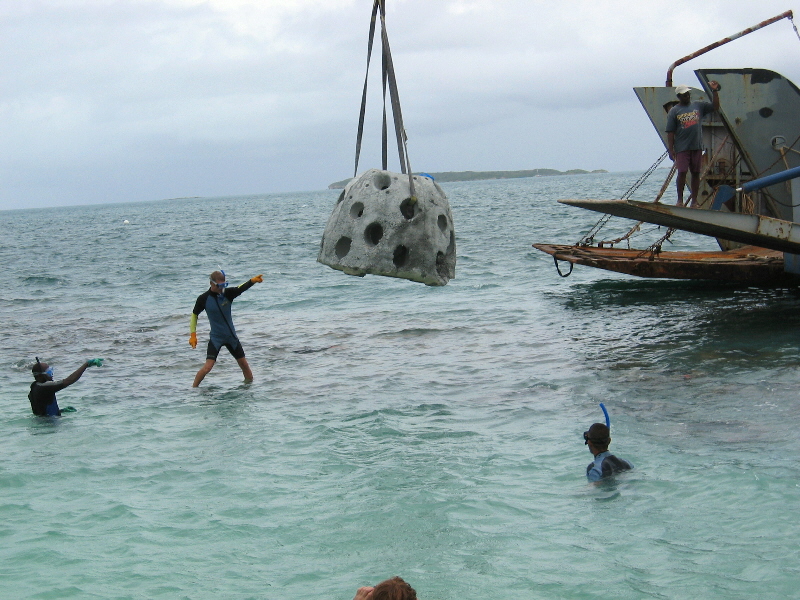Overview
Stanford Development Company Ltd. (SDC) and the Reef Ball Foundation, Inc. recently conducted the world’s largest total marine ecosystem restoration, which included both coral reef and mangrove habitats. Approximately 3,500 Reef Balls, prefabricated concrete modules designed to mimic natural reefs, were installed around Maiden Island on both its windward and leeward sides. On the windward side of the island, 1,200 Reef Balls were used to create the world’s largest fringing breakwater reef system.
Constructed in just 2 months, the reef system was planted with live corals salvaged from a future dredging site and then propagated using innovative new methods. In all, 5,000 new coral colonies, including threatened Staghorn (A. cervicornis) and Elkhorn corals (A. Palmata), were permanently attached to adapters in the Reef Balls to form a functioning reef. On the leeward side of the island, an integrated restoration was designed in which 2,000 Reef Balls were deployed to create a breakwater reef, and more than 4,200 red mangrove (Rhizophora mangle) seedlings were planted along the shoreline. Because mangroves are so important for the health of coastal ecosystems–e.g. shoreline stabilization, habitat for juvenile fish and other marine life, and filtration of pollutants from incoming fresh water– it is hoped that this multifaceted restoration will yield greater environmental benefits than either project would if done separately.
Quick Facts
Project Location:
Maiden Island, Antigua and Barbuda, 17.0957001, -61.88718349999999
Geographic Region:
Caribbean
Country or Territory:
Antigua & Barbuda
Biome:
Coastal/Marine
Ecosystem:
Coral Reef, Seagrass & Shellfish Beds, Estuaries, Marshes & Mangroves
Project Lead:
Stanford Development Company Ltd. (SDC) and the Reef Ball Foundation, Inc.
Organization Type:
Private Company
Location
Project Stage:
Implementation
Start Date:
2003-11-21
End Date:
2004-03-21
Primary Causes of Degradation
Urbanization, Transportation & IndustryDegradation Description
Maiden Island’s windward reef was destroyed in 1995 when Hurricane Luis, a Category 4 hurricane, passed directly over Antigua and Barbuda.
Project Goals
The Reef Balls will serve many purposes including protecting seagrasses from boating scars, stabilizing the island’s beaches to create better conditions for corals and other marine life (i.e. less siltation), and serving as substrate to create a richly diverse coral reef.
Monitoring
The project does not have a monitoring plan.
Description of Project Activities:
Over 3,500 Reef Ball modules were constructed on the Island of Antigua. One thousand two hundred of these modules were deployed from a barge on the windward side of Maiden Island to form the windward breakwater reef and dive-snorkel trail. The remaining 2,000 modules were built for the lee-side breakwater, and as part of the island's Reef Ball red mangrove planting project. Eight different sizes and over 100 different design styles of Reef Ball modules were incorporated into this project to more closely mimic a natural reef. Reef Balls were chosen because the alternative--an armor stone breakwater--would have negatively impacted thousands of square feet of seagrass beds. The Reef Balls were designed with special open bottoms to allow sea grasses to flourish around and under the modules so that conch (Strombus gigas) habitat would be preserved. The Reef Ball construction site had an average of 100 workers building Reef Ball modules 24 hours per day, 7 days a week for a period of 2 months. A special concrete mix was developed that allowed the Reef Balls to be cast and deployed rapidly (sometimes within 18 hours of being cast) while still retaining the special marine-friendly formulations that make the concrete's pH match that of natural seawater. The unique textured surface and balanced pH of the Reef Balls is designed so that coral larvae and other marine life can easily affix themselves and quickly grow into adult colonies. The Reef Ball modules were loaded onto barges by cranes, and then crews worked from sunrise to sunset deploying modules at predetermined sites. A Total Station surveying method, which is accurate to within centimeters, was used to ensure that the placement of Reef Balls did not damage existing natural corals. Before the installation of the modules, a special mark had to be established called the 'biological tide line', which is the water level at which marine growth stops. The Reef Balls were made in different sizes so that the top of each Reef Ball would be exactly at the 'biological tide line.' This placement makes for the most effective submerged breakwater, and also maximizes the biological growing surfaces for the new reef. Once the modules were deployed, the Reef Ball Foundation’s Coral Reef Propagation and Coral Reef Rescue teams (composed of experts from around the world who serve as volunteers) began collecting imperiled corals from a proposed dredging site to transplant on the new reef system. These corals were gathered and brought to the 'coral prop table,' a work station in shallow water where propagation activities were carried out. The coral is cut into small fragments and then embedded in a cement plug. Plugs are made with a special cement that contains additives to adjust the pH and a formula designed to set in less than 3 minutes. The cement is mixed with a Water/Adva Flow solution and then poured into standard 'medicine' cups with sand in the bottom to allow easy removal of the set plug. Wearing gloves which are sterilized between each new coral colony, workers insert fragmented pieces of coral into the cement and then place them back in the water after 2 minutes. Full curing occurs in about 20 minutes, and then the plug is popped out of the cup. Using a special underwater epoxy putty, divers fit the plugs into holes in the Reef Balls pre-made for this purpose. Most corals can be rescued, fragmented, plugged, and planted within a few hours, thereby increasing the likelihood of successful transplantation. Thirty different species of imperiled hard and soft corals, including 3,000 free living rose corals and literally tons of brain corals, Gorgonian soft corals, Elk Horn coral, etc., were rescued from dredge operations surrounding Maiden Island. Several species of these corals were fragmented into smaller segments (replicating natural asexual coral reproduction) including threatened Sea Fans (Gorgonia spp.), Elkhorn coral (Acropora palmata), Staghorn coral (A. cervicornis), as well as the less common Fused Staghorn (A. prolifera-robusta). Other fragmented species included Finger corals (Porites porties and P.devaricata), Pillar coral (Dendrogyra cylindricus), Diffuse Ivory Tree coral (Oculina diffusa), and Yellow Pencil coral (Madracis mirabilis), to mention a few. The Reef Ball modules were also aquascaped and planted with coral species that do not lend themselves well to fragmentation--i.e. Diploria sp., Colpophyllia sp. and Meandrina sp. Commonly referred to as brain corals, these species were established, along with Mustard Hill (Porites asteroids, etc.), anemones, desired macro algal, and sponges just to state a few. Over 500 sea urchins (Echinometra lucunter) were added to the reef to act as 'janitors' and keep the corals free from algal overgrowth. Scientifically designed larval lobster settlement substrates were also incorporated into the reef system to enhance survivability of the spiny lobster (Panulirus argus), an important species in Antigua. Finally, many of the Reef Balls were filled one-third full of rocks in order to create additional complexity and habitat for fish. Observations to date have shown this strategy to be effective, as the reef is exhibiting signs of increased juvenile fish populations. The transplanting of imperiled corals, along with the integration of live rock and other invertebrates, will greatly accelerate the formation of a biologically diverse Reef Ball restoration coral reef, thereby improving water quality and habitat. On the leeward side of the island, similar Reef Ball deployment techniques were utilized, and a total of approximately 2,000 modules were installed. Red Mangroves were also planted on this side of the island in order to enhance the marine ecosystem and complement the Reef Ball coral reef. Red Mangrove, or ‘Walking Mangrove’ (Rhizophora mangle), was chosen for use on the island because it forms extensive underwater root systems that provide important habitat for juvenile fish and other marine life. Over 4,200 Red Mangroves were imported into Antigua from Nova Southeastern University's mangrove nursery in Ft. Lauderdale, Florida, and another 3,000 are planned. Upon arrival in Antigua, the mangroves are placed in a special nursery area, where they are afforded an opportunity to grow somewhat and become acclimated before they are transplanted. Once transplanted, the seedlings must be stabilized and protected until they become fully established. This project employed small, prefabricated Reef Balls as underwater “pots,” in lieu of other stabilization techniques involving PVC encasement tubes. The Reef Balls, lined with burlap to retain soil and anchored with a length of rebar, will ensure that young mangroves are not damaged or uprooted by waves before they can develop resilient roots.
Ecological Outcomes Achieved
Eliminate existing threats to the ecosystem:
There were 11 species of fish observed on the reef during the project’s preparatory phase. The volunteer teams have since documented 73 fish species, 71 invertebrates spp., 30 corals spp., 26 algal spp., and 1 turtle on the newly restored reef. Every day the species list continues to grow (see link in references section for a detailed list). Within three weeks of being built, the reef was host to a documented spawning event of over 100 large Gray Snappers (Lutjanus griseus). Starting about two hours after sunset, these fish hover near the ocean bottom. A dominant fish (in this case a very large Gray Snapper) appears to entice this group into making rapid ascents to the surface. The fast and spectacular ascents occur almost daily and are oftentimes accompanied by an explosion of eggs and milt. This is the first documented formation of a new spawning site, and it has major implications for future fish stock management. The coral rescue and propagation effort was quite successful. Although some of the corals that were rescued had experienced stress from sedimentation, only 200 fragments were lost (out of a total of 5,000). The majority of these losses were in the Staghorn and Elkhorn families, and all of the other species had survival rates exceeding 95%. In fact, within just three weeks, many corals (including Staghorns, Elkhorns and Finger Corals) were seen "basing," or growing out over the Reef Balls. This indicates the corals are healthy and will exhibit high rates of survival. Among other project successes, the following achievements were realized: 1) The creation of over 5,000 new coral colonies encompassing 30 different species 2) The rescue and transplantation of over 17.5 tons of corals from dredging operations without a single coral family loss. 3) The re-establishment of 4 new coral species lost from Maiden Island during Hurricane Luis 4) The rescue and relocation of over 3,000 (free living) rose corals. 5) The stabilization of over 9,000 pounds of loose rocks to help reduce hurricane reef damage. 6) The enhanced genetic diversity of several species of coral (e.g. Finger, Elkhorn, Staghorn, Lettuce, Brains, and soft corals) to strengthen the reef from coral diseases and man-made stresses.
Socio-Economic & Community Outcomes Achieved
Economic vitality and local livelihoods:
Human needs were not forgotten in the construction of the reef either. Stanford Development Company and the Reef Ball Foundation created hundreds of yards of snorkeling and diving trails. These trails provide visitors a complete tour of the reef and afford a glimpse of the wondrous and abundant reef life now present. The trails are marked by Reef Balls that have a 12-inch by 12-inch square marking to make navigation easy.
Key Lessons Learned
This project is the world’s largest total marine ecosystem restoration, and it incorporates all of the latest successful marine restoration techniques. The whole project cost less than traditional breakwaters–which are seldom environmentally friendly–yet produced an end result with far greater beauty, usefulness and environmental sensitivity. Because coral reefs and mangroves engage in such significant biological interaction, the restoration efforts on the leeward side of the island are especially innovative. The newly created mangrove habitat will serve as a natural water filter to help maintain good water quality for the entire coastal ecosystem and will also help ensure an abundance of fish, lobster, and marine invertebrates on the new reefs. The restoration has been so successful thus far that The Antigua Department of Fisheries is now considering measures to protect the new ecosystem. Such protection may include the nearby natural reefs, mangroves stands, seagrass beds, the new spawning grounds, and genetic coral bank reserves, and would undoubtedly create more abundant fisheries in all of Antigua and more effective management of valuable natural resources.
Long-Term Management
Scientists have advocated the creation of genetic coral banks, where different families from the same species are conserved, in case of a need for replanting after a hurricane or other natural disaster precipitates the loss of specific families of coral. This was done for Staghorn, and Elkhorn corals as part of this project, as these species are threatened throughout the Caribbean. There are numerous other proposals for additional long-term monitoring, reef maintenance, public education and reef protection being considered by the Stanford Development Company in association with this project. One proposal involves the addition of mooring buoys so that anchor drops do not damage the new reef. There are also efforts being made by the Reef Ball Foundation and R. Allen Stanford to designate the area as a marine protected reserve.
Sources and Amounts of Funding
Approximately $1,770,000 USD
The Coral Propagation and Coral Rescue Projects were funded by a non-restricted donation from R. Allen Stanford to the Reef Ball Foundation, Inc. (A publicly supported 501 (c) 3 non-profit charity) of $250,000. This money was used to organize the project and resulted in over 275 man days of expert volunteer labor from our Worldwide Coral Propagation Teams. The Mangrove Planting Project is on-going in scope and until the total number of required mangroves is finalized, an exact budget has not been created. However, the Red Mangroves are being purchased from Nova Southeastern University, and so far, about $20,000 worth of seedlings have been purchased (4,200 plants). The Construction Project (building and deploying about 3,500 Reef Balls) was done on Antigua by the Stanford Development Company Ltd. using local labor. Due to the large number and sizes of prefabricated units, this was the most expensive phase of the project and cost an estimated $1,000,000-1,500,000. There are numerous additional efforts being funded either by Stanford Development Group, Reef Ball Foundation, or purely by volunteers. Dr. Judith Goblin did an initial species inventory study of Maiden Island before Reef Balls were introduced. The Antigua St. Johns Chapter of the Optimist Club provided labor to seed Reef Balls with sea urchins to increase natural coral settlement. There are a wide range of monitoring and scientific studies being planned.
Other Resources
List of Observed Fish Species http://www.reefball.com/map/antiguascience/speciesonwindward.htm Reef Ball Foundation, Inc. http://www.reefball.com/map/antiguascience/antiguapressrelease.htm http://www.reefball.com/reefballcoalition/mangroves.htm





